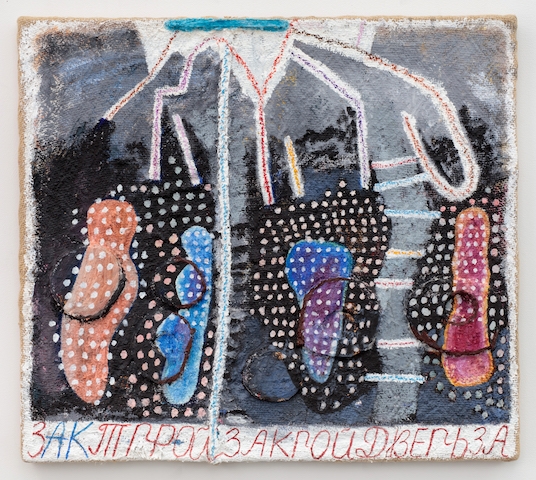I can’t decide if Yevgeniya Baras is playing a primitivist game or an outsider game in art. Her newest paintings, all untitled from 2016 and 2017, and all oil on burlap or canvas with occasional foreign elements, such as wood or glass or branches affixed to or embedded behind their surfaces, exhibit what is becoming something like a signature style: mixtures of both rich and muted hues, thick lines and scumbles, ambiguous symbols, figures and forms emerging from rough surfaces, resulting sometimes from paint, sometimes from the picture’s substrate, and modest canvas sizes, with most dimensions at 60cm or smaller.
In the current series, many paintings bear quasi-Cyrillic text and lettering. This is new. In prior works, such as the ones Baras showed at Nicelle Beauchene Gallery in New York in 2016, only one of the paintings (on my count) involved anything resembling such alphabetic incursions. But in the last two years the letters are more frequent, and more prominent, and the paintings conjure, at least for me, both the mysteries of peasant primitivism, and the Cubo-Futurism that animated the early experiments of the avant-garde in Russia.
Whether Baras wants this is probably beside the point. In the first decades of the last century, text fragments and woodblock lubki were picked up by various Russian artists (Goncharova, Larionov, Malevich) as means to challenge the bourgeois naturalism that had dominated high art in the nineteenth century. The vagaries of text, and the mysticism of the indigenous ‘other’, pointed to hidden dimensions of meaning, deeper truths, that the modernising world was both concealing and uncovering. If art could channel these truths, could take a hammer to its calcified forms, then a new age, a new utopia, might dawn.
I don’t believe Baras is after a new dawn. Such radicality is nothing if not foreclosed from artists of her generation (artists of any generation today, really). But one does sense that Baras is after those mysteries that were once easily associated with the earthy otherness of the rough-hewn and whatever was still out of step with the age. The thick weave and frayed edges of her burlap canvases suggest work and wear (not to mention impoverishment), while her diagrammatic forms and textual annotations are like muddy hieroglyphics meant to undo our contemporary imperative to produce anything instantly recognisable.
It’s to Baras’s great credit, then, that she can produce paintings that appear wholly sincere and strategic at the same time. Baras does not come to her work decorated with anything like the outsider’s badges of autodidacticism and obsession. She was educated at London’s Slade and the University of Pennsylvania in Philadelphia, where she received a BA in fine art and psychology as well as an MS in education (graduating cum laude, no less). Her MFA is from the School of the Art Institute of Chicago. One has to assume that anyone with those intellectual chops understands well the effects she is after – there can be no mystery there.
Yevgeniya Baras: Towards Something Standing Open at The Landing, Los Angeles, 27 January – 10 March
From the April 2018 issue of ArtReview
